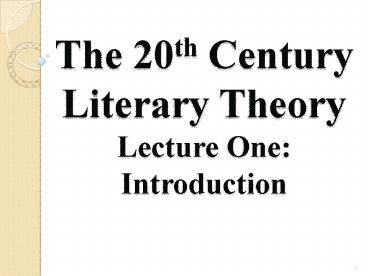The 20th Century Literary Theory Lecture One: Introduction - PowerPoint PPT Presentation
1 / 12
Title:
The 20th Century Literary Theory Lecture One: Introduction
Description:
* Deconstruction Deconstruction emerged in the works of the French Jacques Derrida and ... * The Political Reading of Feminism Political criticism in general claims ... – PowerPoint PPT presentation
Number of Views:185
Avg rating:3.0/5.0
Title: The 20th Century Literary Theory Lecture One: Introduction
1
The 20th Century Literary TheoryLecture
OneIntroduction
2
The problem of theory
- literary criticism became theory-oriented,
especially in the 1980s. - No interpretation of a text was considered to be
serious without a theoretical background. - Theory can be seen as the armour of the critic.
- It provides him or her with systematic inventory
of points of view and techniques of textual
interpretation - However, the danger of too much theory can be
that it outgrows the text to be understood. - It becomes a mere technical jargon which rattles
above the text. - Therefore, it precisely serves the avoidance of
the experience based encounter. - This might even lead to a catharsis-resistent
reading.
3
The problem of theory
- The critic should remain in command of the
various theories. - He or she should apply often more than one theory
to the text. - The critic should select the most appropriate
theories by paying close attention to the nature
of the text. - The nature of the text will invite or even
provoke certain theoretical approaches.
4
Theoretical Approaches
- After the war of theories in the 1980s, some of
the 20th century approaches dissolved into more
recent ones. - Dominant theories tend to live side by side
- Critics quietly adhere to their own favourites.
- The dominant 20th century critical approaches can
be put into two major categories - One tradition focuses primarily on the text,
- The other, first and foremost, focuses on the
context.
5
Theoretical Approaches
- We are going to study four critical approaches
that focus primarily on the text - New Criticism
- Russian Formalism
- Structuralism
- Deconstruction
- We are going to study two critical approaches
that focus primarily on the context - The Political Reading of Feminism
- Postcolonial Criticism and Theory
6
New Criticism
- New Criticism emerged partly in Cambridge,
England in the works of I.A. Richards and William
Empson in the 1930s, and partly in the United
States in the 1940s and 50s, represented by
Robert Penn Warren, Cleanth Brooks, Allan Tate,
etc. - Its basic principle was the close reading of the
text without taking into consideration the
writers life, the historical background, etc.,
and operated with such interpretative tools as
metaphor, metonymy and irony.
7
Russian Formalism
- Russian Formalism developed in the 1920s.
- For a long time, it remained uninformed by
Structuralism in the works of such theoreticians
as Propp and Shklovsky. - A careful distinction was made between story
and plot. - Shklovsky offered the concept of
defamiliarization, which means that literary
representation is able to show well-known
phenomena in a totally new, startling light.
8
Structuralism
- Today, structuralism is largely outdated but
other theories has developed in an active debate
with it e.g. Deconstruction - Structuralism first emerged as a linguistic
theory developed by the Geneva linguist Ferdinand
de Saussure at the beginning of the 20th century. - Saussure claims that language is a system of
signs - The value of each sign is assigned to language by
all the other signs making up the system.
9
Structuralism
- It became a form of literary study in the works
of Roman Jakobson, Gerald Genette, etc. - The main idea of literary Structuralism is that
the total description of the system of signs
constituting a literary work is identical with
its meaning.
10
Deconstruction
- Deconstruction emerged in the works of the French
Jacques Derrida and the Belgian-American Paul de
Man. - It is a response to both Structuralism and New
Criticism. - The basic assumption is that a text is always
more threatening and dynamic. - No description could exhaust its meaning.
- A disturbing, unaccountable residue will always
remain. - This residue will go on, generating newer
meanings in an endless chain of signifiers.
11
The Political Reading of Feminism
- Political criticism in general claims that
literary texts always have a political dimension. - Literary texts can be shown to take specific
stances to social issues, either through what
they say or what they do not say. - Feminism has called attention to pervasive male
bias in Western literature. - It has rediscovered forgotten female writers,
rewriting the canon. - The major figures are Simon de Beauvoir, Virginia
Woolf, Helene Cixous, Elaine Showalter.
12
Postcolonial Criticism and Theory
- The postcolonial theory critically analyses the
relationship between colonizer and colonized. - It focuses on the role of texts, literary or not,
in the colonial enterprise. - It examines how the texts construct the
colonizers masculine superiority and the
colonizeds inferiority as well as the
legitimization of colonialization. - The main thinkers of the theory are Homi Bhabha,
Edward Said, and Gayatri Spivak.































